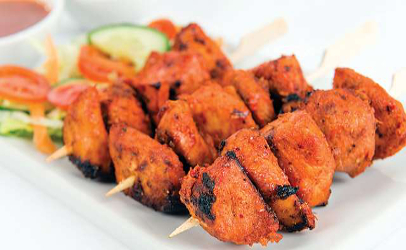 Editor’s note: This article was originally published in the January 2018 edition of Food Irradiation Update and is posted here with permission of the author.
Editor’s note: This article was originally published in the January 2018 edition of Food Irradiation Update and is posted here with permission of the author.
The following is a recap of progress made worldwide with food irradiation, with a focus on advancements in the past 12 months. More food was irradiated in 2017 than in any previous year. Many countries have begun to irradiate foods, especially for reasons of market access. Irradiation is the preferred intervention to prevent harmful insects from hitch hiking shipments of fresh produce destined for foreign shores.
January 2017
Australia’s first-ever shipment of fresh lychees into the United States landed successfully the month before, in December 2016, just in time for the pre-Christmas rush.
To make the plane, the lychees had to go from far north Queensland, where they were picked and packed, to Brisbane to be treated and tested against strict protocols on chemical use, including zero tolerance for pests and defects. The fruit going to the U.S. is being low-dose irradiated, the same as it is for New Zealand, which is a very safe way to send the fruit according to Jill Hauser of the Australian Lychee Growers’ Association.
+++
Australian mango growers began their third U.S. season in January 2017. After many years of work, Australian mango growers and exporters were finally able to ship mangoes to the U.S. market by using USDA/FSIS-approved irradiation. Demand was high and the mangoes sold well. More mangoes from Australia are on the way.
 February 2017
February 2017
North Bay Produce, Traverse City, MI, began importing fresh irradiated pomegranates and figs from Peru.
The USDA-APHIS approved shipments came from Agricola Athos in Lima, Peru. Mark Girardin, president of North Bay Produce, credits the vision of Jorge Checa of Agricola Athos, the valuable cooperation of SENASA PERU, USDA-APHIS, Gateway America, and Federal Strategies, for making this vision become a reality.
The black mission variety figs were shipped by air from Lima and trucked to Gateway America in Gulfport, MS, for irradiation. The fruit then was shipped to distribution warehouses directly or to North Bay Produce’s mid-America facility in Mascoutah, IL.
March 2017
The Seventh Annual Phytosanitary Irradiation Forum at Chapman University was a huge success. Nearly 100 participants from throughout the world were in attendance. The conference helped advance the primary goal to increase awareness and understanding of irradiation as a phytosanitary treatment and thus to facilitate the use of the technology to overcome barriers to trade.
For your reference, presentations may be found online linked to the 2017 agenda at: http://www.chapman.edu/food-irradiation-workshop.
+++
 Bonamar Corp., a U.S. seafood company based in Medley, FL, partnered with Gateway America to launch a new product line marketed nationally as ES (Extended Safety) crab meat products.
Bonamar Corp., a U.S. seafood company based in Medley, FL, partnered with Gateway America to launch a new product line marketed nationally as ES (Extended Safety) crab meat products.
Gateway America, Gulfport, MS, is a Primus Labs Certified food safety facility that will be processing Bonamar’s crab meat under USFDA supervision. The rule applies to raw, frozen, cooked, partially cooked, shelled or dried crustaceans. It also covers cooked or ready-to-cook crustaceans processed with spices or small amounts of other food ingredients.
+++
The government of Canada announced changes to its food and drug regulations to permit irradiation of ground beef. It was a long time coming, though, with the beef industry having requested the change in 1998.
Canadian officials said the government views the technology as another tool for use by the beef industry in improving food safety. Irradiation is not intended to replace existing food safety practices for handling, storage and sanitation. It’s purpose is to complement those practices.
Canada has already approved irradiation to treat potatoes, onions, wheat, flour, spices and seasoning preparations.
 April 2017
April 2017
The U.S. Animal and Plant Health Inspection Service (APHIS) officially allowed the import of fresh star apple fruit from Vietnam into the U.S., using irradiation as a protocol.
One measure identified in the pest risk analysis is that all consignments of fresh star apple fruit from Vietnam imported into the U.S. will be required to be treated with irradiation prior to arrival in the U.S.
Star apple fruit is the fifth Vietnamese fruit being exported to the US. The other fruit are dragon fruit, rambutan, litchi and longan.
+++
The Lasalgaon irradiation centre in India began to process mangoes for export to Australia.
According to norms, irradiation of mangoes is mandatory before they are exported to Australia. Irradiation is also mandatory before export to the United States. Irradiation centers at Lasalgaon and Vashi are already processing mangoes to be exported to the U.S.
Australia had given its nod to mango export from India in June 2016. But, the export could not begin as the mango season had almost ended by then.
May 2017
Fiji is seeking to increase the exports of its fruits and vegetables to international markets, and presented a proposal for an IAEA technical cooperation (TC) project to support food irradiation for the 2018-2019 cycle.
Fiji’s exports of fruit and vegetables are hindered by the presence of different species of fruit fly, which seriously affect the quality of Fijian export products such as okra, papaya, breadfruit, mango, eggplant and chili.
To reduce the impact of insect pests, the country has been treating export products with High Temperature Forced Air (HTFA). Although an HTFA plant to treat fruit and vegetables was built in 1995 at Fiji’s International Airport in Nadi, it has only provided a partial solution to the problem, as it cannot eliminate all the types of flies that affect Fiji’s fruits and vegetables.
To close the gap regarding safe fruit and vegetable exports, and in line with Fiji’s Trade Policy Framework, the government of Fiji has decided to introduce irradiation to address the insect pest challenges facing the country’s exports.
 June 2017
June 2017
Innova Agri Bio Park, a third-party gamma irradiation facility at Malur, near Bengaluru, India, received the Australian government’s approval to process and export Indian mangoes to Australia. Irradiation is a mandatory protocol. Mangoes treated at Innova’s facility qualify for the phytosanitary and food-standard requirement for entry into Australia.
Agri Bio Park planned to export nearly 300 tonnes of gamma-irradiated mangoes to Australia from its Malur facility. Innova’s facility has also been approved by the U.S. Department of Agriculture and the Agricultural and Processed Food Products Export Development Authority in India.
July 2017
Vietnamese dragon fruit is being exported to 40 countries and territories, such as China, Thailand and Indonesia, according to the Ministry of Agriculture and Rural Development (MARD). The fruit is also entering new markets, including India, New Zealand, Australia and Chile.
The Australian embassy also recommended supporting Việt Nam in asking permission from the Food Standards Australia New Zealand to use irradiation treatment on dragon fruit shipped to Australia.
Dragon fruit is a Vietnamese agricultural staple with export earnings of U.S. $895.7 million in 2016, making up 50.3 percent of the country’s fresh fruit exports and 36.1 percent of overall vegetable exports.
August 2017
Pakistan was full of mangoes – the most delicious fruit of the country. In Japan, Pakistani mangoes were sold for $4 a piece, whereas in Pakistan, one can purchase three kilos of mangoes for that amount.
But mangoes cannot be exported to Japan, the U.S. and other countries because Pakistan cannot meet stringent export requirements. The importers fear that pests would enter their countries through untreated mangoes. It is therefore a requirement of the importing countries that the mangoes should be subjected to irradiation or vapor heat before export.
Vapor heat causes deterioration of the fruit and shortens shelf life whereas irradiation is environmentally friendly and extends the shelf life of the fruit. Experts are concluding that irradiation is Pakistan’s best option for market access.
+++
 Scientists in India announced that preservative-free, ready-to-eat food will soon be a reality. Scientists at Bhabha Atomic Research Centre (BARC) have developed a technology to make food items consumable for a longer period of time, while retaining nutritional value.
Scientists in India announced that preservative-free, ready-to-eat food will soon be a reality. Scientists at Bhabha Atomic Research Centre (BARC) have developed a technology to make food items consumable for a longer period of time, while retaining nutritional value.
While a number of ready-to-eat options are available in India already, they are laden with preservatives and tend to lose their nutritional value and taste due to the methods through which they are processed, which includes exposure to heat. BARC scientists use irradiation technology. Products are treated under gamma rays at very low temperatures – minus 40 degrees to prepare frozen food.
They have transferred irradiation technology to a meal manufacturing company that will soon launch ready-to-eat items such as chicken tikka.
September 2017
Post-harvest food and grain losses pose serious challenges for most of African countries. According to estimates provided by the African Post-harvest Losses Information System, the value of post-harvest grain losses in sub-Saharan Africa could total U.S. $4billion a year out of an estimated annual grain production worth U.S. $27billion.
This is roughly equivalent to the value of annual cereal imports in the region during the same period. Given the near-doubling of global grain prices over the last decade, the value of current losses is likely much higher. Conservatively, such a magnitude of food loss could meet the minimum annual food requirements of at least 48 million people across the continent.
In Ghana a significant part of food crops produced are being lost due to number of reasons, including high moisture, pests and other diseases. In some cases as much as 35 percent of cereal and between 20 percent to 60 percent of tubers, root crops and bulbs are lost. Moreover, Ghana losses about 320 000 tons of maize annually, which accounts to 18 percent of the annual maize production.
October 2017
The U.S. Department of Agriculture has paved the way for imports of Vietnamese mangoes. Following a request from Vietnam’s national plant protection organization, USDA’s APHIS staff conducted a pest risk assessment and risk management document on the feasibility of mango imports. The agency concluded that fruit can be imported if it undergoes a systems approach that includes orchard requirements, irradiation treatment and port of entry inspection.
In addition, fruit can only be imported in commercial consignments, and it must be accompanied by a phytosanitary certificate issued by the national plant protection organization of Vietnam.
Vietnam expects to export about 3,000 metric tons of mangoes to the U.S. annually, less than 1 percent of all mangoes exported to the U.S.
For the first time a Darwin, Australia farmer Ian Quinn shipped mangoes to the United States, with 720 trays sent in October. Quinn has been a staunch supporter of irradiation as a phytosanitary process. His success shows that irradiation is a tool that can be used by small farmers to add value to their products.
 November 2017
November 2017
Over 200 farmers in East Java, Indonesia, have used the variety Inpari Sidenuk — “nuclear dedication” in Indonesian — arming themselves against the effects of climate change while doubling their yields to 9 tons per hectare. Inpari Sidenuk is one of 22 rice varieties developed by scientists at the country’s National Nuclear Energy Agency (BATAN) using irradiation, a process often used to generate new and useful traits in crops.
The IAEA, in cooperation with the Food and Agriculture Organization of the United Nations (FAO) supports researchers in 70 countries, including Indonesia, in the use radiation for agricultural research. The development of new, improved varieties helps increase food supply and therefore food security around the world.
 About the author: Ronald F. Eustice has been involved in the commercial introduction of irradiated foods since 1997 while he was serving as executive director of the Minnesota Beef Council. During the past 20 years, Eustice has spoken at food safety conferences in more than 30 states and 10 countries about consumer acceptance of irradiated food in the marketplace.
About the author: Ronald F. Eustice has been involved in the commercial introduction of irradiated foods since 1997 while he was serving as executive director of the Minnesota Beef Council. During the past 20 years, Eustice has spoken at food safety conferences in more than 30 states and 10 countries about consumer acceptance of irradiated food in the marketplace.
(To sign up for a free subscription to Food Safety News, click here.)
